Prior authorization (PA) was supposed to serve as a safety net, checking that patients get the right treatment while keeping costs in check. In reality, it now sits among the biggest administrative hurdles in healthcare. The contrast is stark when you consider how fast the market is growing. The U.S. healthcare software-as-a-service sector was worth about $11 billion in 2024 and is projected to grow to roughly $21 billion by 2030. Yet, even as money pours into digital health, many clinics still rely on old, paper-based prior-authorization workflows, creating a clear mismatch.
Doctors and their teams feel the impact of prior authorization every day. According to a 2024 American Medical Association survey, each physician spends roughly 13 hours a week completing these forms. In addition, 40% of physicians say they have staff members whose sole responsibility is to handle prior authorizations.
The fact that insurers keep leaning on these rules makes it clear we need a different approach. Recent policy tweaks and new technology give us a real chance to overhaul the system. By putting AI-powered health-insurance software into the mix, we can turn prior authorization from a slow, manual chore into a smoother, streamlined process, one that actually fulfills its original purpose without slowing down patient care.
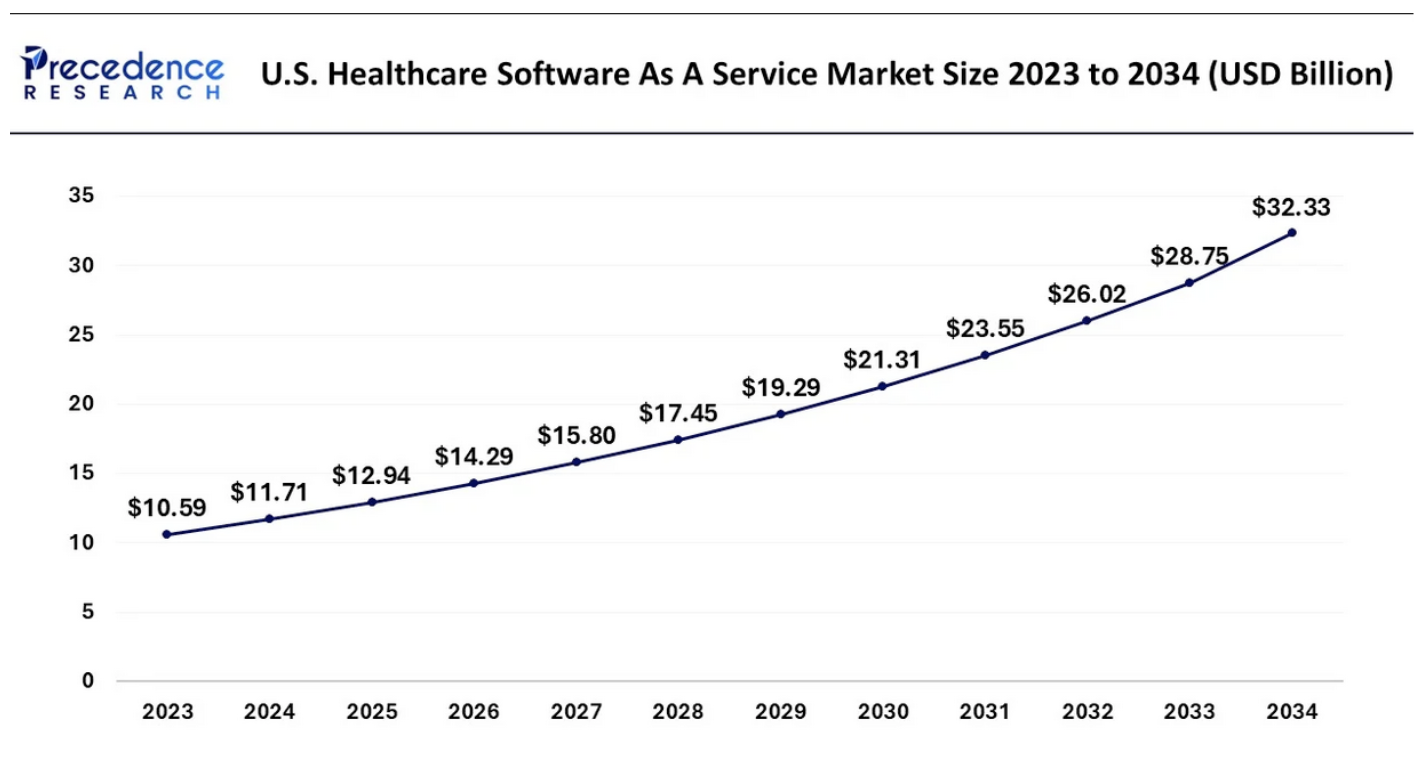 Source: Precedence Research
Source: Precedence Research
What makes the current prior authorization process so damaging?
The PA workflow today looks like a patchwork of manual tasks and siloed steps, so providers constantly hit friction points while patients endure longer waits.
Why Traditional Processes Are Failing
What makes prior authorization such a problem is that the whole process is still split up and heavily manual. The
CAQH Index for 2024 reports that only about 35% of authorizations now travel through a fully electronic, standardized channel. The remaining requests continue to be shuffled around via phone calls, faxes and a set of separate payer web portals.
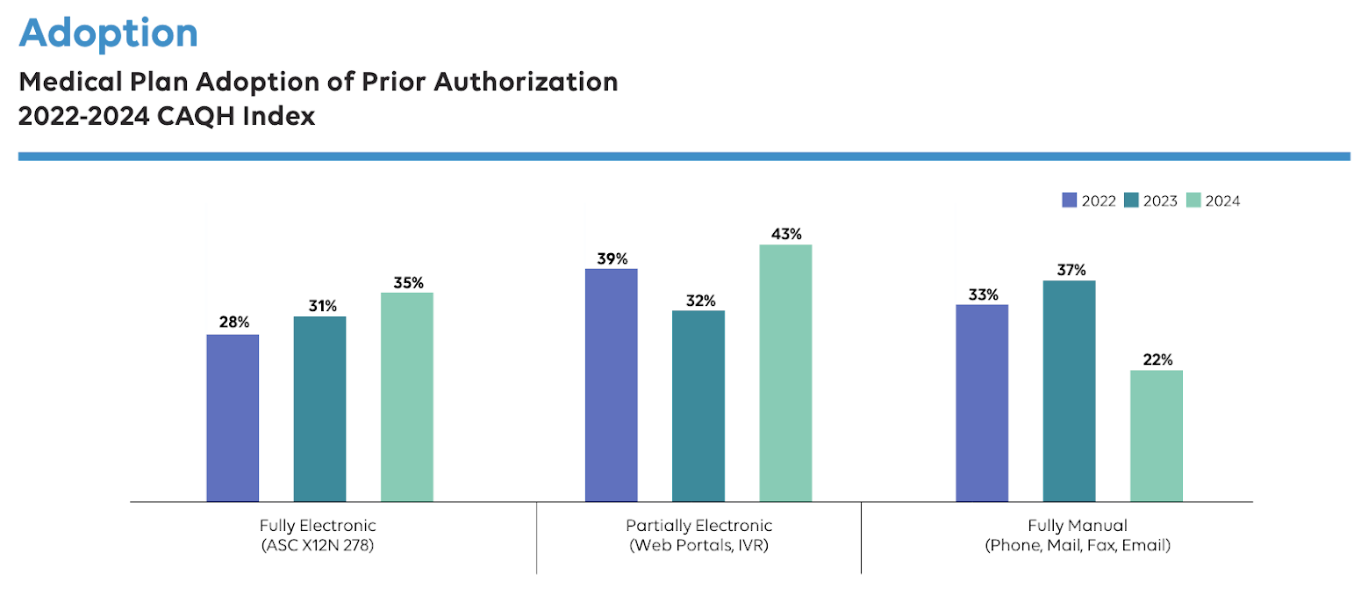
Source: CAQH
This manual process forces staff to:
- Hop from one payer portal to another just to confirm a patient’s benefits or to see whether a prior authorization is needed. Each portal has its own layout and rules.
- Sift through long, constantly changing policy documents that are scattered across PDFs and web pages. A single example is UnitedHealthcare’s radiology guidelines, which span more than 3,000 pages.
- Spend a lot of time on the phone; one analysis found that a single clarification call can keep a staff member on hold for 15–20 minutes.
- Pull clinical notes out of the EHR, then type the same information into a different system, duplicating effort and raising the chance of mistakes.
When every step lives in a separate corner, the whole process drags down productivity and stretches out turnaround times for both routine and complex cases.
The Human Cost of Inefficiency
The administrative flaws built into prior authorization can harm patients and wear down providers. The American Medical Association points out that
94% of physicians say PA has a somewhat or clearly negative effect on clinical outcomes.
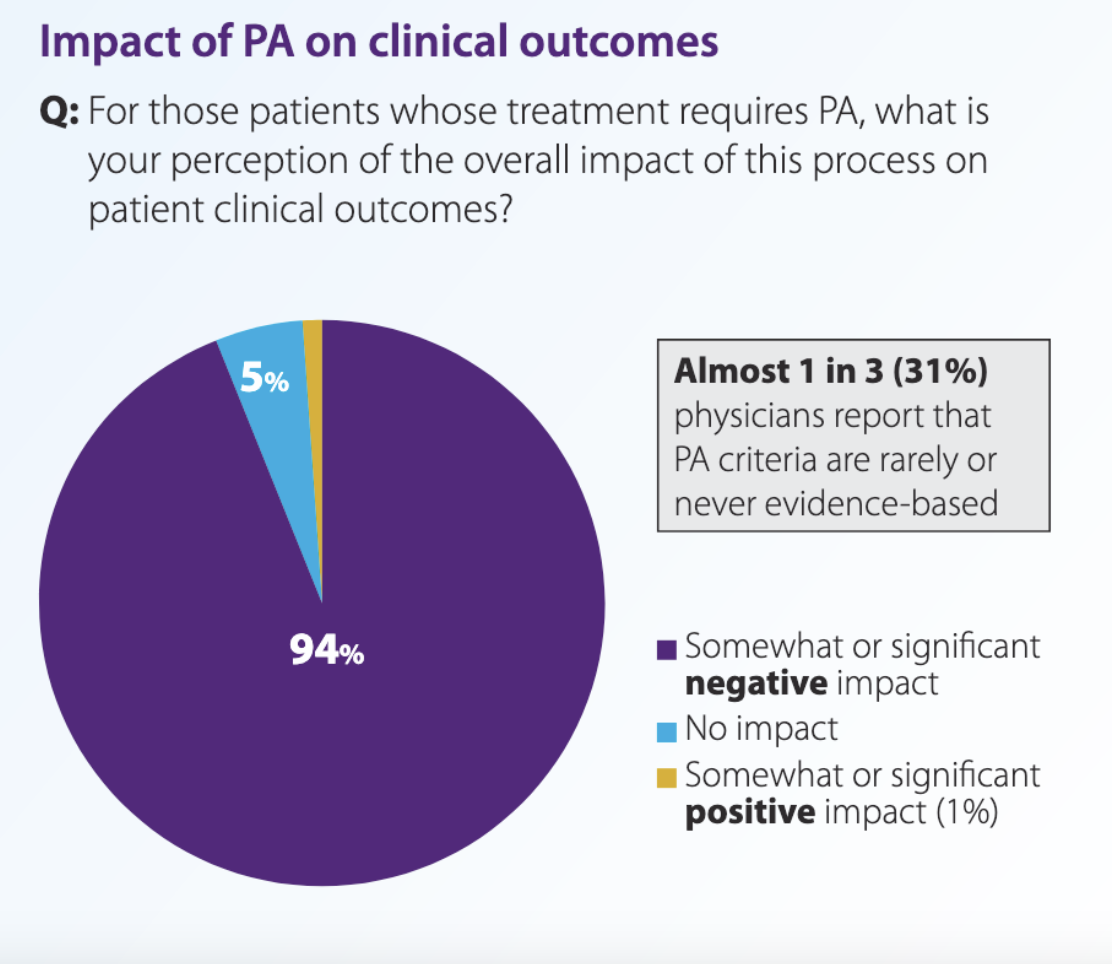
Source: American Medical Association
These setbacks show up in concrete ways:
- Treatment abandonment: 82% of doctors say PA problems cause patients to give up on the therapy their doctor prescribed.
- Serious adverse events: More than one in four physicians (29%) have witnessed a serious adverse event that stemmed from a PA delay or denial.
- Hospitalization: Nearly a quarter of physicians (23%) report that a PA obstacle ended with the patient being admitted to the hospital.
For doctors, wrestling with these bureaucratic hurdles feeds burnout. The same AMA poll indicates that 89% of physicians feel PA adds to their burnout level. That strain spreads beyond the individual clinician, threatening the stability of the healthcare workforce and the quality of care patients receive.
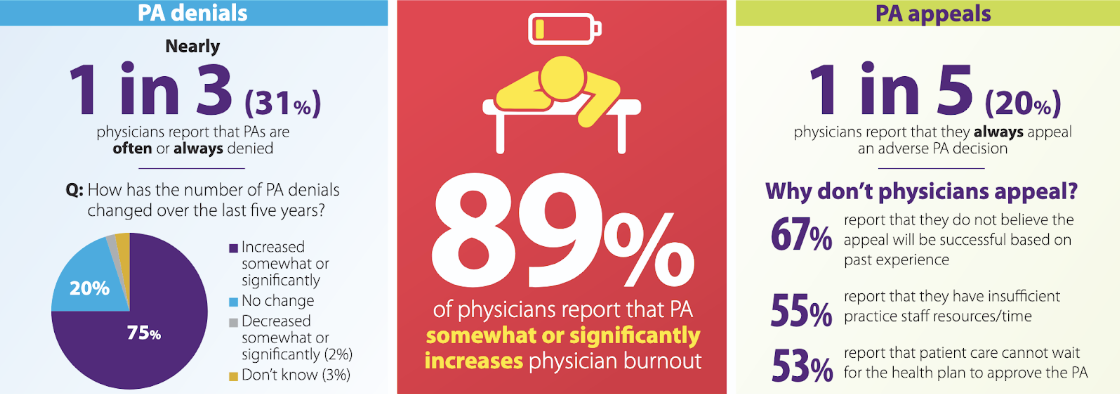
Source: American Medical Association
How can AI-powered software fix prior authorization?
Artificial intelligence can be used to overhaul the prior-authorization process from the ground up. When we combine machine learning, natural language processing and automation, we can create connected platforms that handle the workload for clinicians. At Kanda, we apply these same technologies to help healthcare organizations streamline prior authorization and improve patient outcomes through
generative-AI–powered solutions.
Creating a Unified, Intelligent Workflow
Rather than making staff toggle among separate tools, an AI-driven platform pulls every prior-authorization task into a single, unified view, often embedded straight into the EHR. The AI agents can initiate eligibility checks on their own, retrieve the plan-specific PA rules, and auto-fill submission forms with the patient’s data. From that point, each request follows the right path, whether it’s a modern API, a payer portal, or fax when required, all managed from one screen.
Automating Clinical Documentation and Review
Gathering the clinical documentation needed to demonstrate medical necessity remains one of the most labor-intensive steps in the prior authorization workflow. By employing AI-driven intelligent document processing that combines natural language processing with optical character recognition, the system can automatically ingest and interpret unstructured sources such as physician notes, laboratory reports and faxed forms.
AI agents then analyze a patient’s records within the EHR, cross-reference them against the specific payer guidelines, and extract the pertinent data like progress notes, imaging results, prior treatments and other required elements, to back the request. The platform highlights the criteria that are already satisfied, flags any missing information, and ensures that each submission is complete and defensible on the first attempt.
Enabling Real-Time Decision Making
Automating both data gathering and analysis with AI can slash prior-authorization turnaround times dramatically. In a
real-world collaboration, Regence health plan partnered with MultiCare health system to embed an AI-driven solution that communicates via FHIR standards, letting clinicians launch authorization requests straight from their EHR.
The impact was striking: where MultiCare patients once waited an average of 15 days for a decision, the new workflow produced near-real-time determinations, often while the patient was still in the exam room. This example illustrates how intelligent automation can eliminate care delays and give patients and providers immediate clarity.
What are the essential features of an AI-powered PA system?
Creating a truly effective AI-driven prior authorization platform means focusing on the capabilities that directly solve the problems of the manual workflow.
A modern system should include:
- Intelligent Document Processing: The platform must automatically capture and structure clinical data from a variety of inputs like free-text physician notes, faxed documents, PDFs and other unstructured sources, by leveraging natural language processing alongside optical character recognition.
- Smart Decision Engines: By applying machine learning models, the system can study past authorization decisions and automatically approve low-risk requests that consistently satisfy medical necessity rules. This offloads routine work from clinical reviewers, letting them concentrate on the more intricate cases. In fact, several major insurers already use comparable AI to auto adjudicate over 80 % of incoming claims without any human intervention.
- Multi-Payer Integration: A unified platform must be able to connect with hundreds of payers using every available channel ranging from modern APIs to each payer’s proprietary web portal, and even legacy methods such as fax or phone, so staff no longer have to learn and navigate a patchwork of disconnected systems.
- Seamless Ecosystem Integration: The solution must weave into the existing healthcare IT stack, especially EHR platforms, to retrieve clinical data and embed the prior authorization workflow right where clinicians operate. Discover more about the nuances of EHR integration here.
Meeting a New Era of Regulatory Compliance
Automation isn’t driven solely by the promise of faster workflows; evolving regulations are a major catalyst, too. The U.S. Centers for Medicare & Medicaid Services (CMS) has ratified the
Interoperability and Prior Authorization Rule (CMS-0057-F), which will require health plans to meet new standards by 2026–2027. The rule’s core mandates are:
- FHIR-Based APIs: Payers must deploy HL7 FHIR-compliant APIs to enable electronic exchange of prior authorization requests and decisions.
- Accelerated Decision Windows: Payers are obligated to render decisions within 72 hours for expedited requests and within 7 calendar days for standard requests.
- Greater Transparency: Plans will have to publicly disclose their PA metrics, including approval and denial rates, to foster accountability.
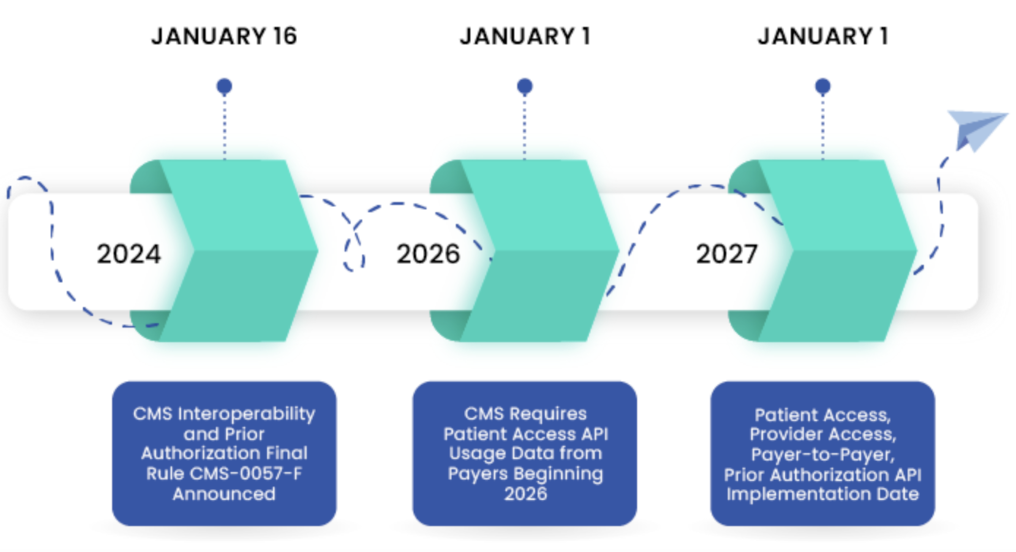
Source: VNB Health
Meeting these obligations calls for an AI-powered solution. Machine learning and real-time data processing allow the system to handle the tighter timeframes while maintaining HIPAA-compliant security.
Kanda in Action: Streamlining Authorization in Precision Oncology
Intelligent automation is already changing how healthcare tackles some of its toughest problems. A great example is
Kanda’s work with Trapelo, a real-time precision medicine platform helping bring next-generation cancer care to life.
Trapelo was built to simplify one of oncology’s biggest challenges, making sure treatment decisions and insurance coverage stay in sync with the latest clinical evidence. Its platform gives oncologists real-time, evidence-based guidance when ordering tests and choosing treatments, helping ensure that every care path fits both the patient’s needs and their insurance policy.
One of the platform’s key roles is acting as a single-order management system that cuts through the red tape of prior authorization for complex and often costly molecular tests, so patients don’t have to wait as long to start treatment.
As demand for Trapelo grew, Kanda stepped in to help migrate the platform to a scalable, efficient, and HIPAA-compliant AWS cloud infrastructure. The new setup streamlines how clinical orders are processed and shared, makes collaboration between oncologists, labs, and payers much smoother, and ensures reimbursements happen without the usual administrative drag that slows down critical care.
How Can Kanda Help?
Scaling prior authorization takes expertise, a deep understanding of the healthcare ecosystem, and a clear, well-planned roadmap to pull it off. Development teams have to juggle legacy system integrations, keep data security airtight, and build high-performance architectures that meet every regulatory requirement, all at once.
- Build Custom AI-Powered Platforms: We engineer secure, scalable and fully compliant software and APIs that are tailored to your unique operational and scientific workflows, handling the full complexity of prior authorization processes.
- Manage Legacy System Integration: Our team designs robust data transformation pipelines to bridge older practice, EHR and other legacy systems with modern, cloud-based AI solutions, ensuring a seamless transition without disrupting current operations.
- Ensure Security and Compliance: From the ground up, we build platforms that satisfy stringent regulatory mandates such as HIPAA, GMP, FDA requirements and now the new CMS interoperability rules, especially for organizations that also operate in regulated clinical or manufacturing contexts. We safeguard your data and your business at every layer.
- Develop Interoperable Applications: We create powerful support tools for clinicians and administrators that unlock the full value of your data while guaranteeing smooth interoperability across the broader healthcare ecosystem.
Reach out to our experts to see how Kanda can help you modernize prior authorization with AI-driven solutions that cut delays, simplify workflows and enhance patient care.
Conclusion
The healthcare sector now faces a turning point: the migration from clunky, isolated administrative tools to unified, intelligence-driven enterprise platforms. Prior authorization cannot be solved with piecemeal tweaks; it requires a comprehensive overhaul powered by AI.
Modern development practices that prioritize automation, smooth integration, and strict compliance are helping organizations finally move past the prior authorization bottleneck. The payoff is lower costs, greater efficiency, and better tools for clinicians to deliver faster, safer, and more effective care.

 Source: Precedence Research
Source: Precedence Research
 Source: CAQH
This manual process forces staff to:
Source: CAQH
This manual process forces staff to:
 Source: American Medical Association
These setbacks show up in concrete ways:
Source: American Medical Association
These setbacks show up in concrete ways:
 Source: American Medical Association
Source: American Medical Association
 Source: VNB Health
Meeting these obligations calls for an AI-powered solution. Machine learning and real-time data processing allow the system to handle the tighter timeframes while maintaining HIPAA-compliant security.
Source: VNB Health
Meeting these obligations calls for an AI-powered solution. Machine learning and real-time data processing allow the system to handle the tighter timeframes while maintaining HIPAA-compliant security.



